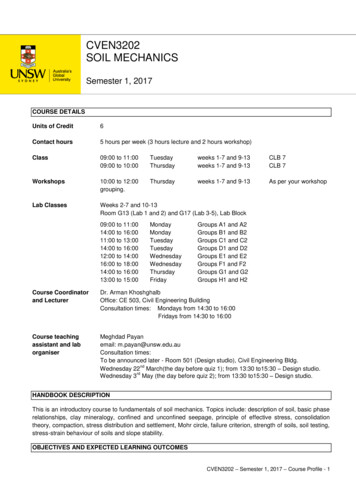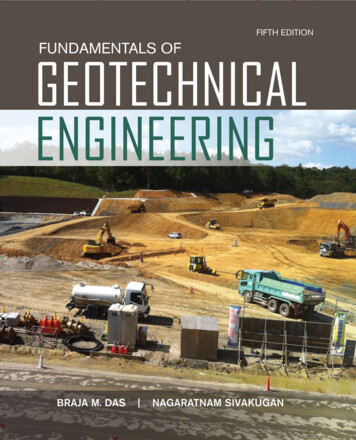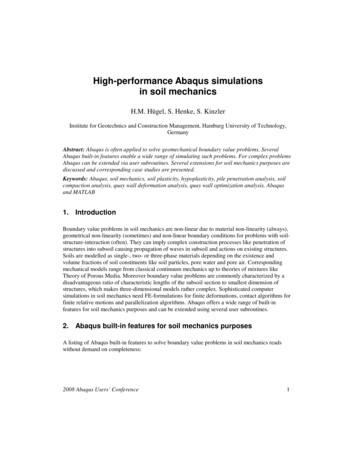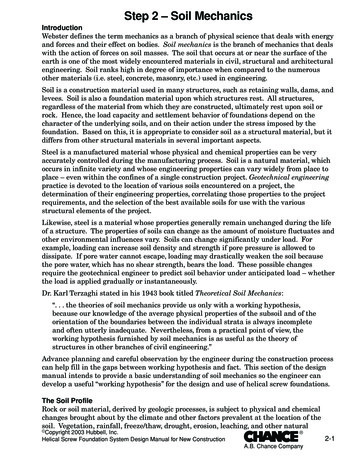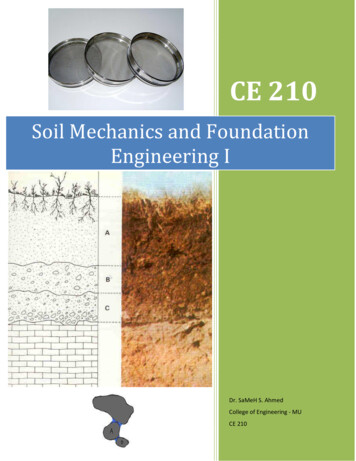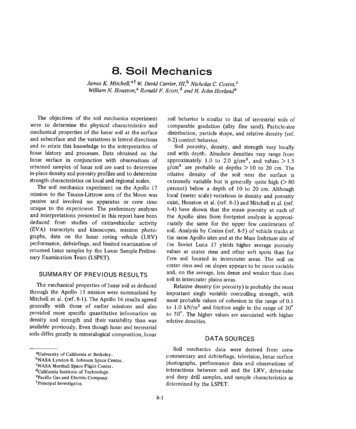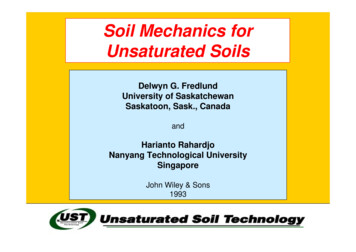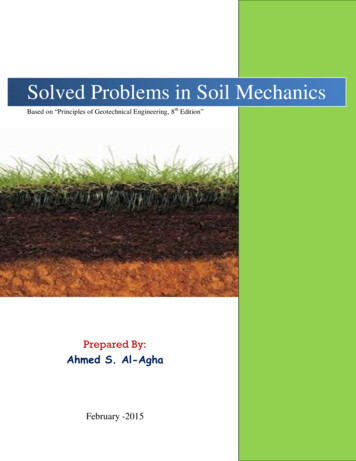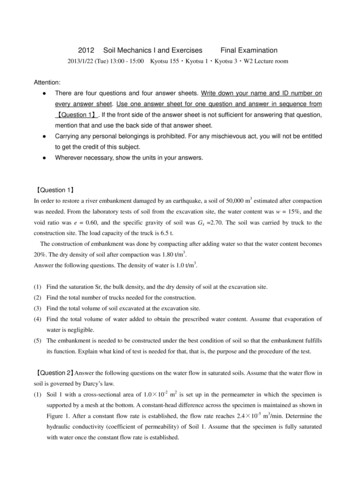
Transcription
2012Soil Mechanics I and ExercisesFinal Examination2013/1/22 (Tue) 13:00 - 15:00 Kyotsu 155・Kyotsu 1・Kyotsu 3・W2 Lecture roomAttention: There are four questions and four answer sheets. Write down your name and ID number onevery answer sheet. Use one answer sheet for one question and answer in sequence from【Question 1】. If the front side of the answer sheet is not sufficient for answering that question,mention that and use the back side of that answer sheet. Carrying any personal belongings is prohibited. For any mischievous act, you will not be entitledto get the credit of this subject. Wherever necessary, show the units in your answers.【Question 1】In order to restore a river embankment damaged by an earthquake, a soil of 50,000 m3 estimated after compactionwas needed. From the laboratory tests of soil from the excavation site, the water content was w 15%, and thevoid ratio was e 0.60, and the specific gravity of soil was Gs 2.70. The soil was carried by truck to theconstruction site. The load capacity of the truck is 6.5 t.The construction of embankment was done by compacting after adding water so that the water content becomes20%. The dry density of soil after compaction was 1.80 t/m3.Answer the following questions. The density of water is 1.0 t/m3.(1) Find the saturation Sr, the bulk density, and the dry density of soil at the excavation site.(2) Find the total number of trucks needed for the construction.(3) Find the total volume of soil excavated at the excavation site.(4) Find the total volume of water added to obtain the prescribed water content. Assume that evaporation ofwater is negligible.(5) The embankment is needed to be constructed under the best condition of soil so that the embankment fulfillsits function. Explain what kind of test is needed for that, that is, the purpose and the procedure of the test.【Question 2】Answer the following questions on the water flow in saturated soils. Assume that the water flow insoil is governed by Darcy’s law.(1) Soil 1 with a cross-sectional area of 1.0 10-2 m2 is set up in the permeameter in which the specimen issupported by a mesh at the bottom. A constant-head difference across the specimen is maintained as shown inFigure 1. After a constant flow rate is established, the flow rate reaches 2.4 10-5 m3/min. Determine thehydraulic conductivity (coefficient of permeability) of Soil 1. Assume that the specimen is fully saturatedwith water once the constant flow rate is established.
Figure 1(2) Calculate the flow rate when Soil 1 is overlain by Soil 2 with a thickness of 0.1 m and a hydraulicconductivity of 1.0 10-5 m/s as shown in Figure 2. Assume that Soils 1 and 2 are fully saturated with water,and a constant flow rate is established.Figure 2(3) Plot the variations of total, potential, and pressure heads in Soils 1 and 2 along the horizontal axis of a graph,with elevation as the vertical axis, under the constant-flow condition described in Question (2). Assume thatthe bottom level of Soil 1 is the datum.【Question 3】Answer the following questions with reference to Fig. 3, where a normally consolidated clay layerlays between two layers of sand.(1) When a uniform load of P0 40 kN/m2 is applied on the ground surface, find the total stress, the effectivestress and the pore water pressure at the center of the clay layer (i.e., at a depth of 5 m) for the followingthree cases: i) before the application of the load, ii) just after the loading; and after sufficient time has elapsedfor the settlement to finish. Note, the unit weight of water is 9.81 kN/m3.(2) Find the final settlement of the clay layer. Use the stress at the center (i.e., at a depth of 5 m) as arepresentative value of the stress of the full layer. Note, for the clay layer, the initial void ratio e0 2.0 and thecompression index Cc 2.0.
Use the following approximate common logarithm values:log 1.8 0.26, log 2.0 0.30, log 2.2 0.34, log 2.4 0.38, log 2.6 0.41,log 2.8 0.45, log 3.0 0.48(3) Find the days needed for the consolidation to reach U 80%. Use the following table of the relation betweenthe degree of consolidation U and the time factor Tv. [Take cv 1.5x10-3 cm2/s].U 2870.4030.5670.848Sand layerGs 2.65, e 0.76.0 m1.0 mGs 2.65, e 0.7w 5%Clay layerGs 2.70e0 2.03.0 m2.0 mp0 40 kN/m2Sand layerFigure 3Gs 2.65e 0.6
【Question 4】Answer the following questions related to consolidation of soils.(1) Consider a stress state for soil element shown in Fig. 4. Calculate the shear stress and the vertical stressacting on the A-A’ plane (upward) which is inclined 45º. Draw a Mohr’s stress circle and indicate the pole. yx 20 kPa yy 100 kPaThe stress components are xx 50 kPa, yy 100 kPa, 20 kPa.A’y45 xy 20 kPa xx 50 kPaAx.Figure 4(2) Describe Mohr-Coulomb’s failure criterion in terms of principal stresses and explain the criterion by aMohr’s stress circle and its feature.
2013 Soil Mechanics I and Exercises2014/01/28 (Tue.) 13:00 15:00Final ExamRoom: W2Attention: The exam consists of four questions for which you are provided with four answer sheets. Write downyour name and ID number on every answer sheet. Use one answer sheet per question and answerthem in sequence, starting from Question [1]. If the front side of an answer sheet is not enough foranswering one specific question, you can use the back side of the same answer sheet, after clearlymentioning so. All exam questions carry the same weight. In addition to personal writing instruments, rulers and non-programmable calculators are permitted,but programmable calculators and all types of mobile phones are prohibited. If you behave maliciously during the exam, you will not be entitled to get any credit on this course. Wherever necessary, show the units in your answers.【1】 An embankment is constructed from the soil excavated from an excavation site. After completion, the totalvolume of this embankment is 20,000 m3. The soil from the excavation site is investigated in its naturalconditions and the following results are obtained:Bulk density: 1.80 t/m3Water content: 16.0%Specific gravity of soil grains: 2.70In addition, from the results of compaction tests conducted for the excavated soil, the optimum watercontent is found to be equal to 19.0%, at which the maximum dry density is equal to 1.80 t/m3. During theconstruction of the embankment, water is sprayed and the optimum water content condition is reached. Atthis optimum water content condition, the maximum dry density of the embankment is 90.0% of themaximum dry density obtained during the compaction test (i.e., degree of compaction 90.0%). Answerthe following questions considering the density of water as 1.00 t/m3:(1) Calculate the void ratio, porosity, degree of saturation and dry density of the soil at the excavation site inthe natural condition.(2) Calculate the volume and mass of the soil to be excavated from the excavation site in the natural condition.(3) Calculate the mass of water that is necessary to be sprayed on 1 m3 of soil which is in natural condition atthe excavation site.(4) Calculate the degree of saturation of the embankment after the completion of compaction.
【2】 The following figures represent three stages of an experiment on one-dimensional flow of water in thevertical direction through the soil contained in a percolation cylinder, satisfying Darcy’s Law. Thecross-sectional area of the cylinder is 1000 cm2, the saturated unit weight of the soil specimen is sat 19.0kN/m3, and the unit weight of water is w 9.81 kN/m3. Assuming that the datum is located at the bottomof the soil specimen, answer the following questions:(1) When a constant head permeability test was carried out under the conditions shown in figure (a), the flowof water through the soil specimen was 120 cm3/min. Calculate the coefficient of permeability of the soil.In addition, calculate the total head, the elevation head, the pressure head, and the effective stress at thebottom of the soil specimen.(2) Next, as shown in figure (b), the water table at the bottom of the soil specimen was raised to a height of 4 m.Calculate the total head, the elevation head, the pressure head, and the effective stress at the bottom of thesoil specimen under this new condition.(3) Later, as shown in figure (c), the height of the soil specimen was lowered, and a constant head permeabilitytest was carried out. Other than the height of the soil specimen, the experimental conditions are identical asthose in (2). The height of the soil specimen was gradually lowered from its original 2 m, until quicksand(boiling) conditions were reached at a height of L (m). Calculate the value of L.(4) Describe the falling head permeability test, compare it to the constant head permeability test, and mentionunder which conditions each one is used.In figures (a), (b), and (c), thehatched area represents the soil1m1m4m4m2m2mLm1m(a)(b)(c)
【3】 The ground shown in figure 1 consists of a sand and a normally consolidated clay layers on top of animpermeable rock. The groundwater level coincides with the ground surface (i.e., the upper surface of thesand layer). To answer the following questions, assume that the unit weight of water is w 9.8 kN/m3. Tocalculate the settlement due to one-dimensional consolidation, consider that the physical properties of themiddle of the clay layer correspond to the whole layer. Assume that sand is a full drainage material and,therefore, no excess pore water pressure occurs within the sand layer.(1) Calculate the initial total stress, pore water pressure (hydrostatic pressure), and effective stress, at themiddle of the clay layer.(2) Assume that the groundwater level, which coincided with the ground surface at the beginning of thisanalysis, rises 1 m in a short period of time, as shown in figure 2. Calculate the effective stress at themiddle of the clay layer under the new condition, after a sufficient amount of time passes, and alsodetermine the settlement of the clay layer.(3) Instead of the groundwater level rise of (2), assume that it drops, from the initial condition described in (1),to the upper side of the clay layer, in a short period of time. Calculate the effective stress at the middle ofthe clay layer under this condition, after a sufficient amount of time passes, as well as the settlement of theclay layer. Since the water table is now located below the sand layer, the latter will be in an unsaturatedcondition with a unit weight of t 18.5 kN/m3. For this sand layer, assume that the changes in depth due tosubsidence, as well as of its physical properties, are negligible.(4) Calculate the time required for the consolidation process under the conditions described in (3) to reach 90%(Time factor Tv 0.848). If the impermeable layer at the bottom of the clay layer was a drainage boundaryClay: sat 16.2 kN/m3, Initial void ratio e0 2.4,Compression index Cc 1.2, Coefficient ofconsolidation cv 1.2 10-2 m2/dayFigure 12m 1mSand: sat 19 kN/m3Sand: sat 19 kN/m3Clay: sat 16.2 kN/m3, Initial void ratio e0 2.4,6m6m2minstead, how much time would it take for the consolidation process to reach 90%?Compression index Cc 1.2, Coefficient ofconsolidation cv 1.2 10-2 m2/dayFigure 2
【4】 Answer the following questions:(1) Explain unconsolidated undrained shear strength (UU strength).(2) Explain the behavior of loosely and densely compacted sands during consolidated drained shear test (CDtest) using the graphs shown below. Here, 1- 3 is deviator stress, is axial strain and v is volumetricstrain (take compression as positive). 1- 3 1- 3 v v(ii) Dense sand(i) Loose sand(3) A soil element is under the action of stresses shown below. At this condition, obtain the stress componentsacting on the horizontal plane A-A by drawing Mohr’s stress circle using the Pole method. Also, do showthe pole in the figure drawn.600 kN/m2200 kN/m230 AA200 kN/m2600 kN/m2
2014Soil Mechanics I and Exercises Final Exam2015/2/3 (Tue.) 13:00-15:00 W2 Lecture roomAttention: The exam consists of four questions for which you are provided with four answersheets. Write down your name and ID number on every answer sheet. Use one answersheet per question and answer them in sequence, starting from Question [1] If thespace provided in the answer sheet is insufficient, use the back page after clearlymentioning so (for example, “continued on back page”). In addition to personal writing instruments, non-programmable calculators arepermitted, but programmable calculators and all types of mobile phones areprohibited. Any attempts at cheating on the exam will result in failed credit of thecourse and serious penalties. Wherever necessary, specify the units in your answers.[Question 1] In determining the causes and remedial treatments of landslides, it isimportant to understand the amount and state of soils at disaster sites. Herein, the grounddisplaced from its original position on slope as shown in Figure 1 becomes loosened asshown in Figure 2 by movement in landslide. Still, it is assumed that the displaced groundis homogeneous both before and after the failure. A field investigation based ontopographic survey revealed that the original volume of the displaced ground was 2000m3 and it increased to 2500 m3 after the failure. Soil samples were taken immediatelyafter the landslide from the displaced ground and, after a laboratory test, the water contentwas measured to be w 20.0%. In addition, according to the results of a past soil survey,it is known that density of soil particle for the original ground is ρs 2.60 g/cm3 (or thespecific gravity of soil particle Gs 2.60) and dry density is ρd 1.60 g/cm3. Under theseconditions, determine the following properties showing the calculation processes. Usegravitational acceleration 9.8 m/s2, and include units whenever necessary.V 2 000 m3Figure 1 Before landslideV 2 500 m3Figure 2 After landslide
(1) Void ratio of the original ground(2) Total weight of the displaced ground(3) Bulk density of the displaced ground(4) Dry density of the displaced ground(5) Degree of saturation of the sloping ground just before the occurrence of the landslide(by assuming that the water content before and after the occurrence of landslide isunchanged)[Question 2] For the following questions about flow of water in fully saturated soils,assume that Darcy’s Law applies.(1) An undisturbed sample of soil was taken from the field to measure permeability in alaboratory setting. Assume that water density is w 1.0 103 kg/m3, and accelerationof gravity is g 9.8 m/s2.SoilSamplePerforatedMetallic MeshFigure 3 Diagram of the apparatus used to run the constant head permeability1) Before running the permeability test, the bulk density t, water content w, and soilparticle density s of the soil sample were measured, and the following values wereobtained: t 2.0 103 kg/m3,w 20%, s 2.70 103 kg/m3. Calculate thevoid ratio e of this specimen.2) Find the saturated unit volume weight sat of this specimen.3) Figure 3 shows a diagram of the constant head apparatus used to measure thepermeability of this soil sample. The cylindrical mold containing the soil sample has
an inner diameter of 6.0 10-2 m and a height of 0.50 m. Plot the total head, elevationhead, and water pressure diagrams for the whole range z 0 m to z 0.75 m. Inparticular, show all values at z 0.1 m, 0.6 m, and 0.75 m. Assume that the datum islocated at z 0 and that the soil is fully saturated.4) Under the conditions in 3), the downstream water flow rate is 14 cm3 per minute.Calculate the coefficient of permeability k.5) Under the conditions in 3), plot the total stress, pore pressure, and effective stressdiagrams for the range z 0.1 m to z 0.6 m, indicating all values at 0.1 mintervals. Assume that the void ratio is the same that you calculated in 1).(2) When plotting a flow net to analyze flow of water through an isotropic soil (hydraulicconductivity is the same in all directions), the streamlines (flow channels) andequipotential lines form square shapes. Explain why (you may use a figure if necessary).[Question 3] Figure 4 represents a soil with alternate deposit layers of sand and clay. Thephysical properties of each layer are shown within the figure. The clay in the clay layeris normally consolidated, and the water table lies at a depth of 2 m from the ground surface.Below the water table, all soils are fully saturated with water, and it is assumed that thepore water pressure is consistent with the hydrostatic pressure. Answer the followingquestions considering the sand layers as perfect drainage material and the unit weight ofwater as w 9.8 kN/m3.(1) Calculate the vertical total stress, pore water pressure, and vertical effective stress, atthe center of the clay layer.(2) If a uniform surcharge load q 50 kN/m2 is applied on the ground surface, calculatethe vertical total stress, pore water pressure, and vertical effective stress at the center ofthe clay layer after a sufficient amount of time has passed. At that time, calculate the totalconsolidation settlement of the clay layer, and its final void ratio. Assume that the stressin the center of the clay layer can be used as representative of the whole clay layer, andthat changes in the physical properties of the soils associated with the consolidationsettlement and depth are negligible.(3) Derive Terzaghi’s one-dimensional consolidation equation expressed by the followingformula. Explain the assumptions and variables used in its formulation.߲ ݑ ݇ ߲ଶ ݑ ൌ߲ ݉ ݐ ௩ ߛ௪ ߲ ݖ ଶHere, u is the excess pore water pressure, t is time, k is the coefficient of soil permeability,
mv is the coefficient of volume compressibility, and z is the vertical coordinate.(4) If the coefficient of soil permeability for the clay layer is 1.0 10-9 m/s, and itscoefficient of volume compressibility is 2.5 10-4 m2/kN, calculate the time required toreach 90% of the total consolidation (Time factor Tv 0.848).Depth z (m)0Sand24Bulk Unit Weight 17 kN/m3Saturated Unit Weight 20 kN/m3Saturated Unit Weight 16 kN/m3ClayInitial Void RatioCompression Index12 2.40 1.2SandFigure 4 Soil with alternate deposits of sand and clay[Question 4] The stress state of a given point in the ground where the horizontal andvertical directions coincide with the directions of the principal stresses, is shown in Figure5. Using cohesion c and internal friction angle ϕ, answer the following questions.Figure 5 Stress state of in the ground(1) When the principal stress σz σa in the vertical direction and the principal stress σx σbin the horizontal direction, the state of stress of the soil stays admissible (does not reach
failure condition). Draw the Mohr’s stress circle of this condition by taking σa σb, as wellas the Mohr-Coulomb failure criterion.(2) From the state of (1), while keeping the principal stress in the horizontal directionσx σb constant, the principal stress in the vertical direction σz is gradually increased fromσa until it eventually reaches failure when σz σc. Draw the Mohr’s stress circle of thiscondition as well as the Mohr-Coulomb failure criterion.(3) In regard to (2), using the geometrical relation between a Mohr’s stress circle and theMohr-Coulomb failure criterion, formulate σc in terms of σb, c and ϕ.(4) According to the state of stress given in (2), determine the normal stress and shearstress that satisfy the failure criteria. In addition, find the angle of the failure planeinclined from the horizontal plane.
In order to restore a river embankment damaged by an earthquake, a soil of 50,000 m3 estimated after compaction was needed. From the laboratory tests of soil from the excavation site, the water content was w 15%, and the void ratio was e 0.60, and the specific gravity of soil was G s 2.70. The s

